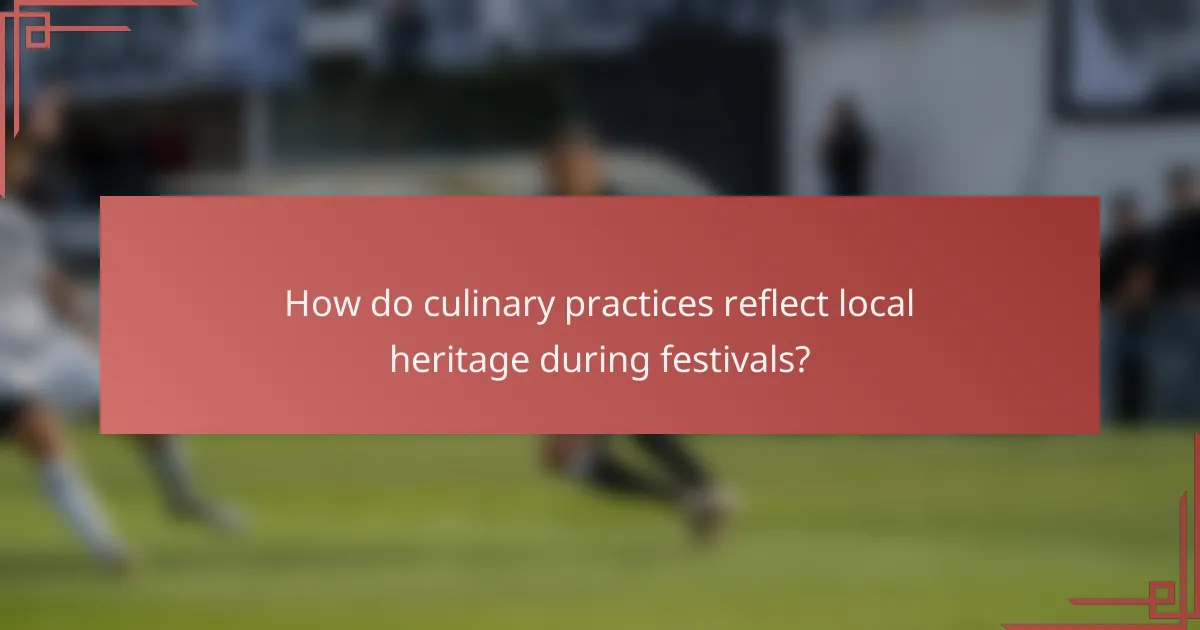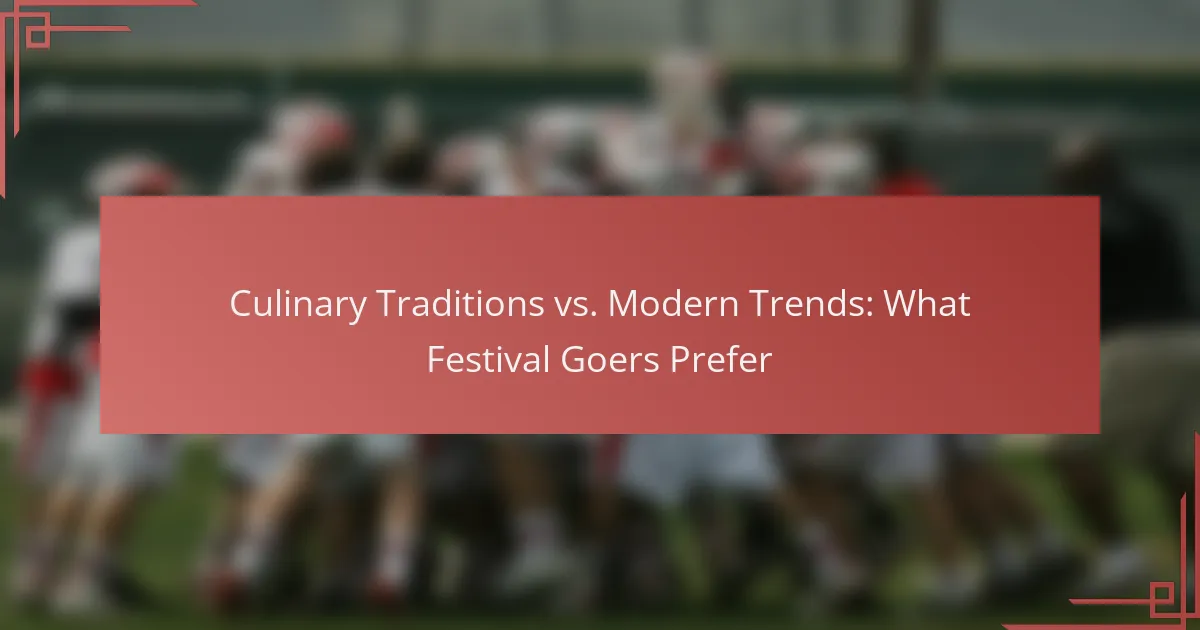Culinary traditions are integral to cultural identity at festivals, as they embody the history, values, and social practices of a community. Through the celebration of local ingredients and cooking techniques, these events create a sense of belonging and continuity, drawing participants into a shared experience of heritage and community spirit.

How do culinary traditions shape cultural identity at festivals?
Culinary traditions play a crucial role in shaping cultural identity at festivals by reflecting the history, values, and social practices of a community. The foods served during these events often symbolize heritage and foster a sense of belonging among participants.
Food as a cultural symbol
Food often serves as a powerful cultural symbol, representing the unique identity of a community. Dishes prepared during festivals can evoke memories and stories that connect individuals to their ancestors and traditions. For instance, dishes like tamales in Mexican celebrations or dumplings in Chinese New Year highlight the significance of cultural heritage.
Moreover, the presentation and sharing of food during festivals can reinforce communal ties, as families and friends gather to enjoy traditional meals together. This shared experience strengthens cultural bonds and fosters a sense of pride in one’s heritage.
Traditional recipes and community bonding
Traditional recipes are often passed down through generations, serving as a means of preserving cultural identity. These recipes not only showcase local ingredients but also embody the cooking techniques and flavors unique to a region. For example, the preparation of a classic paella in Spain involves specific methods that reflect local customs.
During festivals, the act of cooking and sharing these traditional recipes can enhance community bonding. People often come together to prepare meals, creating a collaborative environment that fosters relationships and strengthens community ties.
Regional variations in festival cuisine
Festival cuisine varies significantly across regions, influenced by local ingredients, climate, and cultural practices. For instance, seafood dishes are prevalent in coastal festivals, while hearty meat-based dishes may dominate in inland celebrations. This diversity showcases the rich tapestry of culinary traditions within a country.
Understanding these regional variations can enhance the festival experience. Participants can explore different flavors and cooking styles, gaining insight into the cultural significance of each dish. This exploration not only broadens culinary horizons but also deepens appreciation for the cultural identity represented at the festival.

What are the most significant culinary festivals worldwide?
Some of the most significant culinary festivals worldwide celebrate local traditions, ingredients, and cooking techniques, showcasing the cultural identity of their regions. These festivals often attract thousands of visitors, offering a unique blend of food, music, and community spirit.
Oktoberfest in Germany
Oktoberfest, held annually in Munich, is the world’s largest beer festival, attracting millions of visitors. This festival not only highlights German beer but also features traditional foods like pretzels, sausages, and roast chicken, reflecting Bavarian culinary heritage.
Visitors can enjoy a variety of local dishes while participating in festivities that include music, dancing, and parades. The atmosphere is vibrant, with large tents set up by breweries serving their specialties, making it a key event for both locals and tourists.
Diwali in India
Diwali, known as the Festival of Lights, is celebrated across India and features a rich array of traditional foods that vary by region. Sweets like ladoos and jalebis are commonly prepared, symbolizing joy and prosperity, while savory dishes like samosas and pakoras are enjoyed during family gatherings.
The culinary aspect of Diwali is integral to the celebrations, as families often prepare elaborate meals together. Sharing these dishes with friends and neighbors fosters a sense of community and reinforces cultural ties during this significant festival.
La Tomatina in Spain
La Tomatina, held in Buñol, is a unique festival where participants engage in a massive tomato fight. While the event is primarily known for its playful chaos, it also highlights local gastronomy, as tomatoes are a staple ingredient in Spanish cuisine.
Food plays a role in the festival beyond the tomato fight, with local restaurants offering traditional dishes like paella and tapas. This celebration not only showcases the fun of food but also emphasizes the importance of local ingredients and culinary traditions in Spanish culture.

How do culinary practices reflect local heritage during festivals?
Culinary practices during festivals serve as a vibrant expression of local heritage, showcasing traditional recipes, ingredients, and cooking techniques that have been passed down through generations. These practices not only celebrate cultural identity but also foster community bonds and continuity of traditions.
Use of indigenous ingredients
Indigenous ingredients are central to festival cuisine, as they highlight the unique agricultural and ecological characteristics of a region. For instance, in Italy, local festivals often feature dishes made with regional cheeses, olives, and grains, reflecting the area’s agricultural history. Utilizing these ingredients not only supports local farmers but also preserves the flavors and traditions specific to that culture.
Incorporating indigenous ingredients can enhance the authenticity of festival dishes. For example, using native herbs and spices can create a distinct taste that resonates with local culinary heritage, making the festival experience more meaningful for attendees.
Cooking methods passed through generations
Traditional cooking methods are often preserved and celebrated during festivals, showcasing techniques that have been handed down through families. Methods such as wood-fired cooking, fermentation, or specific grilling techniques can be seen in many cultural celebrations. These practices not only impart unique flavors but also connect participants to their ancestors’ culinary practices.
For instance, in many Asian festivals, the art of steaming dumplings or making rice cakes is a communal activity that reinforces family ties and cultural identity. Engaging in these time-honored methods allows participants to experience a tangible link to their heritage.
Storytelling through food
Food at festivals often serves as a medium for storytelling, conveying historical narratives and cultural significance. Each dish can tell a story about the community’s past, its struggles, and its triumphs. For example, a dish that features a blend of spices may reflect the historical trade routes that influenced local cuisine.
Moreover, sharing food stories during festivals fosters a sense of belonging and identity among participants. Engaging with the history behind certain dishes can deepen appreciation for cultural traditions, making the culinary experience more enriching and memorable.

What role do food vendors play in festival culture?
Food vendors are essential to festival culture as they provide diverse culinary experiences that reflect local traditions and enhance the overall atmosphere. They serve as a bridge between cultural heritage and contemporary tastes, allowing festival-goers to engage with the community’s identity through food.
Economic impact on local communities
Food vendors significantly contribute to the economic vitality of local communities during festivals. They create jobs, stimulate local economies, and often source ingredients from nearby farms and suppliers, which keeps money circulating within the community.
For example, a festival in a small town can generate thousands of dollars in revenue for local businesses, from food sales to increased foot traffic in shops. This economic boost can lead to long-term benefits, such as improved infrastructure and community development.
Promotion of local culinary arts
Festivals provide a platform for local chefs and food artisans to showcase their culinary talents and traditional recipes. This exposure helps preserve culinary heritage while also encouraging innovation and experimentation with local ingredients.
Many festivals feature cooking demonstrations, tastings, and competitions that highlight regional specialties, allowing attendees to appreciate and learn about the local food culture. This promotion can lead to increased interest in local dining establishments and food-related tourism.
Encouraging cultural exchange
Food vendors at festivals facilitate cultural exchange by introducing attendees to diverse cuisines and culinary practices. This interaction fosters understanding and appreciation of different cultures, as people share their food traditions and stories.
For instance, a festival featuring international food vendors can create a vibrant atmosphere where attendees sample dishes from various cultures, sparking conversations and connections. This exchange not only enriches the festival experience but also promotes inclusivity and community cohesion.

How can culinary traditions be preserved at festivals?
Culinary traditions can be preserved at festivals through active community engagement and structured educational initiatives. By involving local chefs and home cooks in workshops and classes, festivals can ensure that traditional recipes and cooking methods are passed down to future generations.
Community workshops and cooking classes
Community workshops and cooking classes are effective ways to engage festival-goers in culinary traditions. These sessions can be led by local chefs or experienced home cooks who share their knowledge of traditional dishes and cooking techniques. For example, a festival might offer a series of hands-on classes where participants learn to prepare regional specialties, such as paella in Spain or dumplings in China.
To maximize participation, festivals can schedule these workshops at various times throughout the event, accommodating different audiences. Offering classes for both adults and children can foster a sense of community and encourage families to engage with their culinary heritage together.
Documentation of recipes and techniques
Documenting recipes and cooking techniques is crucial for preserving culinary traditions at festivals. This can be achieved through printed materials, such as recipe booklets or flyers, that festival attendees can take home. Additionally, creating video tutorials or live demonstrations can help capture the nuances of traditional cooking methods.
Festivals may also consider establishing a digital archive where recipes and techniques are stored for future reference. This could include contributions from local chefs and community members, ensuring a diverse representation of culinary heritage. By making these resources accessible, festivals can help keep culinary traditions alive long after the event concludes.



